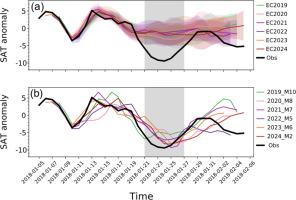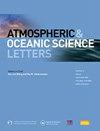东亚极端寒冷事件亚季节预报集合中的高技能成员
IF 3.2
4区 地球科学
Q3 METEOROLOGY & ATMOSPHERIC SCIENCES
引用次数: 0
摘要
极端事件的分季节预报对预警系统至关重要。然而,对极端事件的预测能力是有限的。以2018年1月东亚地区的极端寒冷事件为例,分析了1998 - 2020年东亚地区34次极端寒冷事件,对ECMWF模式集合成员在亚季节时间尺度上的预测能力进行了评价。结果表明,虽然集合均值对3周前极端寒冷事件的预测能力有限,但个别成员表现出较高的预测能力。对于大多数极端寒冷事件,总集合中有10%的成员可以很好地预测14天前的快速温度变化。这凸显了ECMWF模式在亚季节时间尺度上预测极端寒冷事件的潜力。高技能的团队成员依赖于对大气环流模式(500 hpa位势高度、平均海平面压力)和关键天气系统(包括乌拉尔阻塞和西伯利亚高压)的准确预测,这些天气系统会影响极端寒冷事件。本研究针对东亚地区极端低温事件的次季节预报难题,通过分析1998 - 2020年34起东亚地区极端低温事件,并重点关注2018年1月中国东北地区极端低温事件,系统评估不同版本ECMWF模式集合成员之间的预报性能。提前3周的模式集合平均预报性能存在局限, 但不同集合成员的预报技巧存在差异. 部分成员具有高预报技巧, 约10 %的高技巧成员能提前14天捕捉气温快速转折的过程. 研究指出集合成员是否具有高预报技巧依赖于对大气环流演变特征的合理预报. 该发现为极端冷事件次季节预报评估和后期订正提供了新视角, 凸显挖掘集合成员预报潜力的重要性, 并为提升次季节时间尺度预警能力提供了理论支撑.本文章由计算机程序翻译,如有差异,请以英文原文为准。

High-skill members in the subseasonal forecast ensemble of extreme cold events in East Asia
Subseasonal forecasting of extreme events is crucial for early warning systems. However, the forecast skills for extreme events are limited. Taking the extreme cold events in January 2018 as a specific example, and analyzing the 34 extreme cold events in East Asia from 1998 to 2020, the authors evaluated the forecast skills of the ECMWF model ensemble members on subseasonal time scales. The results show that while the ensemble mean has limited skills for forecasting extreme cold events at the 3-week lead time, some individual members demonstrate high forecast skills. For most extreme cold events, there are >10 % of members among the total ensembles that can well predict the rapid temperature transitions at the 14-day lead time. This highlights the untapped potential of the ECMWF model to forecast extreme cold events on subseasonal time scales. High-skill ensemble members rely on accurate predictions of atmospheric circulation patterns (500-hPa geopotential height, mean sea level pressure) and key weather systems, including the Ural Blocking and Siberian High, that influence extreme cold events.
摘要
极端事件次季节预报对防灾减灾保障社会经济安全具有重要意义. 本研究针对东亚地区极端低温事件的次季节预报难题, 通过分析1998–2020年34起东亚地区极端低温事件, 并重点关注2018年1月中国东北地区极端低温事件, 系统评估不同版本ECMWF模式集合成员之间的预报性能. 提前3周的模式集合平均预报性能存在局限, 但不同集合成员的预报技巧存在差异. 部分成员具有高预报技巧, 约10 %的高技巧成员能提前14天捕捉气温快速转折的过程. 研究指出集合成员是否具有高预报技巧依赖于对大气环流演变特征的合理预报. 该发现为极端冷事件次季节预报评估和后期订正提供了新视角, 凸显挖掘集合成员预报潜力的重要性, 并为提升次季节时间尺度预警能力提供了理论支撑.
求助全文
通过发布文献求助,成功后即可免费获取论文全文。
去求助
来源期刊

Atmospheric and Oceanic Science Letters
METEOROLOGY & ATMOSPHERIC SCIENCES-
CiteScore
4.20
自引率
8.70%
发文量
925
审稿时长
12 weeks
 求助内容:
求助内容: 应助结果提醒方式:
应助结果提醒方式:


